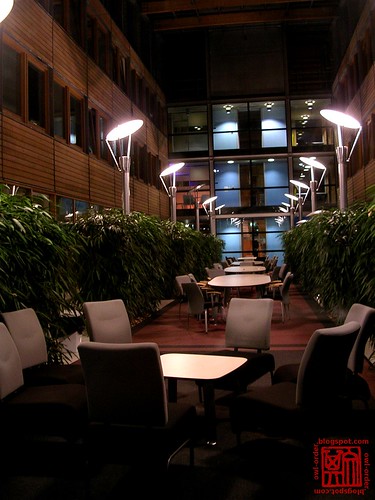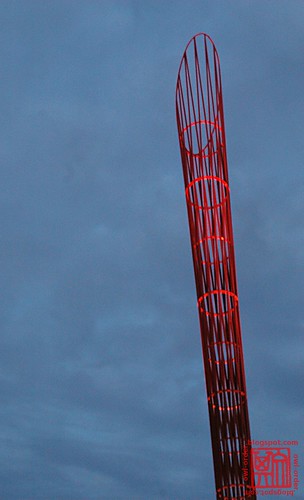I just can't believe it.
Where are the days when I used to trade Pokémon games with my friends in school?
Where are the days when we brought all sorts of junk food to school someday in October to celebrate children's day?
Where are the days when mathematics was literally as easy as 1+1?
Where are the days when paper, scissors, rock could entertain us for hours at a time?
Instead of eating candies, I now drink beer. Oh dear!
Instead of chatting about games online, I now talk about girls. Oh my gawsh!
Instead of doing nothing at home and getting frowned upon by my parents, I now do nothing at home. And don't get frowned. What the hell.
Why has time passed by so fast? I haven't finished enjoying my life as a young, innocent, cute and irresistibly adorable boy yet. It's not fair!!! I want you to go backwards, Time!
What? There's only 4 more weeks before we conclude this decade? 10 years passed? Already?!!!
Oh, that, and my cousin's getting married.
Already??!!! Damn, I AM getting old.
Oh by the way, congratulations to Yue Fang on her wedding.
Can I grow younger now?
New to Owl Order? Click here for 2009's best posts! 00:00:00
Monday, 30 November 2009
Tuesday, 24 November 2009
Photo Editing: Behind the Owl's Eyes
Note: High resolution images of some of the following photos are available. These photos are marked with [HiRes] tags in their captions. Click on the photos to view their higher resolution images.
Photo editing is now almost always synonymous with professional photography. Like it or not, we have to accept the fact that most commercial photos have been digitally nursed to perfection before released to the general public. Smooth-skinned models, mobile phones with irresistibly glossy screens and burgers filled with incredibly golden patties are so commonly seen. Even the smelly yellow material used for the newspaper failed to degrade the quality of the photos.

Before: Trent Building.

[HiRes] After. One of my earlier attempts at more drastic photo editing -- I was trying to improve the dynamic range of my 5-year-old compact camera. And one of the edits that turned out not-that-much-better than the original.
I'm not a real supporter of digital photo editing, but it didn't take me long to realise how a quick tweak here and there can drastically enhance the attractiveness of photos.
The least controversial edit one can make is cropping. It 'cuts' out the sides of the picture, zooming it in and can be easily done even with the most basic software, like Microsoft Paint.
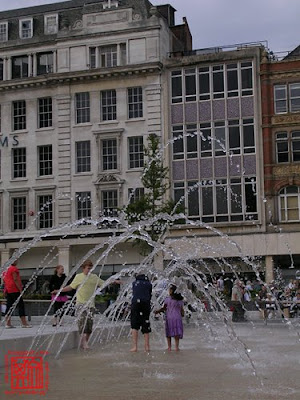
Before: children playing with the fountain at Old Market Square.

After: cropped to give more focus to the children and the water instead of the buildings behind.
While I do not have access to Adobe Photoshop, the holy grail in raster image editing, I do have GIMP installed in my computer. While it isn't nearly as powerful as Photoshop, it has the most important features bundled, and is legally free.
One such feature significant to me is the ability to adjust the picture's brightness/contrast. It does so in three ways -- the basic two-slider, input/output levels and a more advanced brightness curve. This is useful in helping to save so many of my shots with poor dynamic range.

Before: Jubilee Campus from Triumph Road Entrance. It was dark at night and I didn't have a tripod (I never had one).

After. Foreground slightly brightened, with the sky reduced to a more interesting shade of blue. If you look carefully you'll also notice that this picture is slightly rotated and cropped.
I can even select a certain part to brighten, leaving the others in relative darkness.

Before: Jubilee Campus. The subject of this photo, the banner, was rather dark. If the sun were stronger, I could have used the flash to brighten the banner up, but it wasn't and doing so would probably cause visible reflection on the banner.

[HiRes] After. The banner has been brightened, with the other parts untouched. This averts the eyes towards the banner, and along with the (albeit slight) bokeh has thrown the rest of the photo into the background.
Of course, not all of my photos here at my blog are edited. Some escaped relatively unscathed (editing is considered destructive) as they were already good enough.
A photo editor can also easily tune the colour balance of photos. This is useful when the camera's white balance setting is set wrongly when the photo is shot. For example, a scene filled with yellow incandescent light may look whitish on photos. Yellow tint can be added to restore the correct colour balance.

Before: Parliament House, Nottingham City Centre. This was shot in the afternoon.
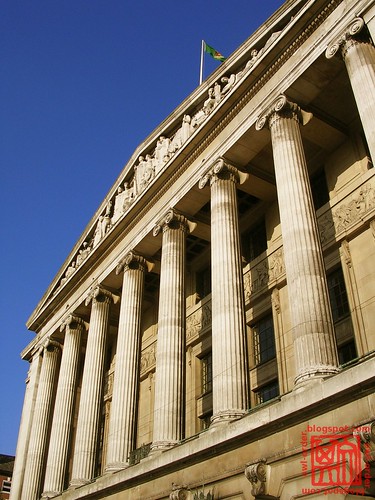
[HiRes] After. Yellow and red added, making the building look as if it were bathed in golden light.

Before: The Atrium, Jubilee Campus.
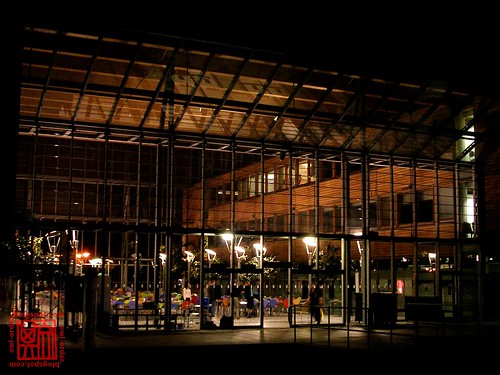
[HiRes] After. Brighter and more contrasty with more saturated colours. This edited photo actually has poorer dynamic range than the original, but throwing the grids into complete shadow over the internal lightings has created an interesting effect.

Before: a bench in the park. Taken in late September.

[HiRes] After. Red and yellow added, giving the entire picture a golden orange glow, all causing the scene look more autumn-like than ever.

Before: duck paddling in the lake, evening. The blue of the water makes it look more like night, though.

[HiRes] After. Orange light to the rescue again.
But of course, photo editing leaves marks, especially from less-than-professional editors (like yours truly).

Before: a gate in the wall. I purposely overexposed this shot, hoping to capture as much detail in the shadow as possible.

After. Split the photo into three sections and applied different colour balance, brightness/contrast settings on them, making it one of my most heavily edited photos to date. Very satisfied with how the wall turned out to be. Took me almost an entire hour on this photo alone and it has editing marks yelling all over.

Zoomed comparison of edit scar. Notice how the brightness of the ground differs in front and behind the iron gate.

Before: Trent Building seen from University Boulevard entrance. It was in the evening, the sun was setting behind the Trent Building, throwing everything (except the sky) into the shadow. A challenging scene for cameras.

After. The sky was slightly darkened, making the colours more saturated. The foreground brightness was tuned up greatly, giving the photo more balance between the sky and the earth.

Zoomed edited photo. Imperfect selection during editing has caused some pixels' brightness to be tuned incorrectly. Some sky pixels are brighter instead of darker.
There are still tonnes a photo editing software can do. One common technique is vignetting, which darkens the edge of the photo to give more attention to the centre. I'd personally like to try HDR (high dynamic range) tone-mapping, which combines several photos of different exposures into a single shot, enhancing a photo's dynamic range significantly. Unfortunately, GIMP isn't able to handle HDR natively, and even if it does, I'll still need a camera with bracketing function and/or full manual mode (preferably an SLR) and a tripod, both of which I have access to only in my wildest daydreams.
Looks like honesty is still the best (and easiest) policy after all.
Labels:
Owl's Eyes
Saturday, 21 November 2009
Independent
I left the comfort of home in 2006 for college, thinking I've finally achieved (at least a certain degree of) independence.
Fast forward the tape by three years, and I quickly realised how wrong I was.
In September, I boarded the plane alone, to fly to a whole new country halfway across the globe, where I was going to spend 9 months with a predefined (and rather tight) budget.
Now, if that doesn't qualify as being independent, what does?
Being brought up by extremely bright (though occasionally slow) parents, I've been trained to be, well, a little paranoid.
I thought I could do it easily, but it was much harder. After waving goodbye to my family (minus one of my sisters), I could literally feel my heart rate go up by the second.
"What if I missed the plane?"
"Oh, shut up, that won't happen. Plus, you're still in Malaysia. Give mum a call and you'll be fine," a second voice inside my head said.
"OK, what if I'm denied entry to UK?"
"You won't! You have a valid student's visa, sufficient cash, health check reports, X-ray, official letters from the University..."
"What if the plane crashes?"
It was then that I knew I was being irrationally paranoid. And I had never had such little faith in Engineers before.
But seriously, in a whole new country, you have to learn to be independent to survive, which is actually quite a bit harder than it sounds.
1. There's no one you can turn to
You're in a new country with few (if any) familiar faces around you. If you have certain troubles, chances are they can't help much. When you had trouble in the past, all you had to do was to yell for mum, but that doesn't happen here. You have to solve it by your own.
Sure, making your own decisions may sound like fun at first, but there's also the saying "with great power comes great responsibilities".
Luckily I have friends here, both from Malaysia and locals. However little they can do to help solve my problems, it is always reassuring to know that I am not alone. Plus, the locals are really friendly, making things quite a bit easier.
2. How to go where?
Being a Klangite, I'm used to having lousy public transport system. You have to wait for ages before a rickety, old bus full of people pull up to the bus stop. There are no light rail transit options in Klang. The taxis are rusty, driven by dodgy drivers and they're nowhere in sight.
My solution? Mum. All I had to do was to make sure I arrange to travel at times convenient for her.
When you're in a new country without your personal driver, however, you have to learn to adapt. Thank goodness -- public transport in UK is fantastic (although a tad expensive). And there's always Google Maps. Input your Starting and Ending Points, and you'll get all the instructions you need, including directions, bus numbers and durations.
Kinda makes you think how our parents managed it without the internet, huh?
3. The tight pocket!
Earning in Ringgit and spending in Pounds is definitely hard -- everything is several times as expensive! To give you an idea, a typical take-out meal costs £4 (the GBP-MYR exchange rate can be found here). Us students are not financially independent yet and we have to be extra careful while spending.
Just to let you know, after failing to secure a part-time job, I now prepare nearly all of my meals by my own. That is, I buy, I clean, I cook, I eat, I wash -- each meal costs less than £1 this way. Yes, I occasionally wake up 6.15am in the morning to prepare not breakfast, but lunch, to pack to school. By the way, my sister is so not going to believe this -- she used to drag me out of bed daily. But the point is, who cares if they don't taste as good (actually my cooking isn't that bad!), who cares if they're a little cold, as long as they're cheap, healthy and filling, they're good enough for me.
Judging by the many fantastic (or what I hope to be fantastic) photos posted here at my blog. you wouldn't have known how much I've been through since touching down in UK. Nevertheless, I don't regret signing up for the exchange programme. I have never felt more grown up before in my entire life, and I have learnt so many of life's important lessons within my first two months in UK.
Three years later (2012)...
I left the comfort of home in 2009 for UK, thinking I've finally achieved (at least a certain degree of) independence.
Fast forward the tape by three years, and I quickly realised how wrong I was.
Fast forward the tape by three years, and I quickly realised how wrong I was.
In September, I boarded the plane alone, to fly to a whole new country halfway across the globe, where I was going to spend 9 months with a predefined (and rather tight) budget.
Now, if that doesn't qualify as being independent, what does?
Being brought up by extremely bright (though occasionally slow) parents, I've been trained to be, well, a little paranoid.
I thought I could do it easily, but it was much harder. After waving goodbye to my family (minus one of my sisters), I could literally feel my heart rate go up by the second.
"What if I missed the plane?"
"Oh, shut up, that won't happen. Plus, you're still in Malaysia. Give mum a call and you'll be fine," a second voice inside my head said.
"OK, what if I'm denied entry to UK?"
"You won't! You have a valid student's visa, sufficient cash, health check reports, X-ray, official letters from the University..."
"What if the plane crashes?"
It was then that I knew I was being irrationally paranoid. And I had never had such little faith in Engineers before.
But seriously, in a whole new country, you have to learn to be independent to survive, which is actually quite a bit harder than it sounds.
1. There's no one you can turn to
You're in a new country with few (if any) familiar faces around you. If you have certain troubles, chances are they can't help much. When you had trouble in the past, all you had to do was to yell for mum, but that doesn't happen here. You have to solve it by your own.
Sure, making your own decisions may sound like fun at first, but there's also the saying "with great power comes great responsibilities".
Luckily I have friends here, both from Malaysia and locals. However little they can do to help solve my problems, it is always reassuring to know that I am not alone. Plus, the locals are really friendly, making things quite a bit easier.
2. How to go where?
Being a Klangite, I'm used to having lousy public transport system. You have to wait for ages before a rickety, old bus full of people pull up to the bus stop. There are no light rail transit options in Klang. The taxis are rusty, driven by dodgy drivers and they're nowhere in sight.
My solution? Mum. All I had to do was to make sure I arrange to travel at times convenient for her.
When you're in a new country without your personal driver, however, you have to learn to adapt. Thank goodness -- public transport in UK is fantastic (although a tad expensive). And there's always Google Maps. Input your Starting and Ending Points, and you'll get all the instructions you need, including directions, bus numbers and durations.
Kinda makes you think how our parents managed it without the internet, huh?
3. The tight pocket!
Earning in Ringgit and spending in Pounds is definitely hard -- everything is several times as expensive! To give you an idea, a typical take-out meal costs £4 (the GBP-MYR exchange rate can be found here). Us students are not financially independent yet and we have to be extra careful while spending.
Just to let you know, after failing to secure a part-time job, I now prepare nearly all of my meals by my own. That is, I buy, I clean, I cook, I eat, I wash -- each meal costs less than £1 this way. Yes, I occasionally wake up 6.15am in the morning to prepare not breakfast, but lunch, to pack to school. By the way, my sister is so not going to believe this -- she used to drag me out of bed daily. But the point is, who cares if they don't taste as good (actually my cooking isn't that bad!), who cares if they're a little cold, as long as they're cheap, healthy and filling, they're good enough for me.
Judging by the many fantastic (or what I hope to be fantastic) photos posted here at my blog. you wouldn't have known how much I've been through since touching down in UK. Nevertheless, I don't regret signing up for the exchange programme. I have never felt more grown up before in my entire life, and I have learnt so many of life's important lessons within my first two months in UK.
Three years later (2012)...
I left the comfort of home in 2009 for UK, thinking I've finally achieved (at least a certain degree of) independence.
Fast forward the tape by three years, and I quickly realised how wrong I was.
Labels:
About Owl
Tuesday, 17 November 2009
Sights of UoN -- A Jog Around the Lake
Note: High resolution images of some of the following photos are available. These photos are marked with [HiRes] tags in their captions. Click on the photos to view their higher resolution images.
The University of Nottingham campuses are well-known for having clock towers built directly facing a lake.
Some 13 months ago, I shot photos of the Malaysian clock tower and lake and posted them here and here.
Today, you'll be seeing the University Park counterparts, the origin of this tradition.

Trent Building seen from the University Boulevard entrance, which is rarely used by students. The lake is actually between the entrance and Trent Building, but it has a lower level and is hidden from view here.
Some two weeks after arriving in UK, I decided to go for a jog around the lake.
Just like the Malaysia Campus's lake, the University Park one has a jogging track surrounding it. The track is much older and worn, but it is also longer (1.95 vs 0.8km), and hence, there's much more to see!
For example, there's this cave near Trent Building. Apparently they have no idea whether it's man-made or natural.
The walls are amazing too. Huge bricks, old iron gates, fallen leaves...
If you were to jog anti-clockwise (that's what I usually do) here, you'll have the lake at your left. With nearly two kilometres of track, you'll be treated with different views at different points of your journey.

[HiRes] The dunno-what-extremely-tall-chimney seen reflected on the lake surface.

The wrong type of crane in the water!
You even get to see the Trent Building from so many different angles!

[HiRes] Hidden among the trees.

[HiRes] Or "through" the trees!

[HiRes] Or with reflection.

[HiRes] With clear blue skies!!!
Jog during sunset and the sights are nothing short of amazing.
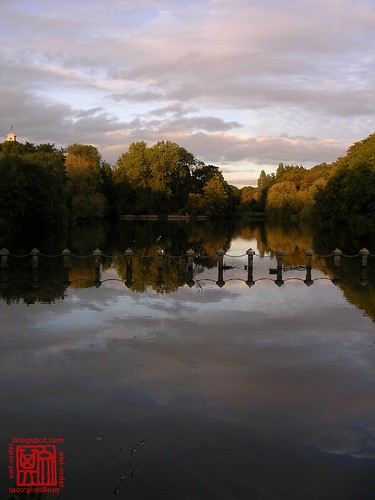
[HiRes] Why is there a row of fence in the water?
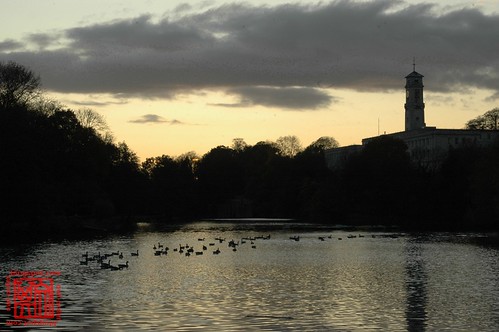
[HiRes] Ducks lining all the way up to Trent Building!
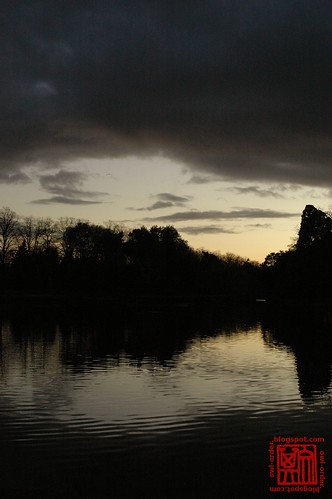
[HiRes] Quiet lake in the evening.
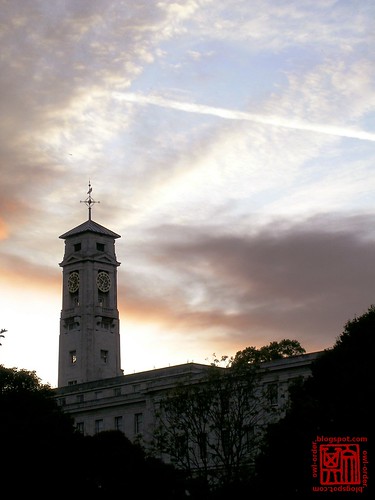
[HiRes] Clock tower against the sunset.
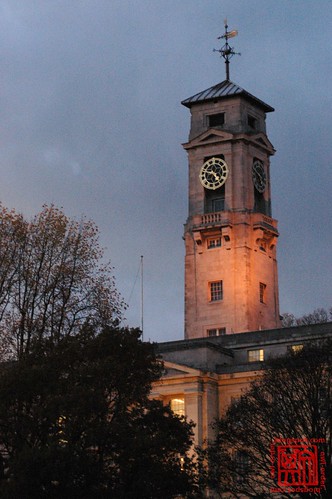
[HiRes] Clock tower, late evening.
If you're no jogger, worry not. You can rent a ball and play putting in the field.
Or you can row/canoe in the lake.
The thing is I've never seen the canoe and ball rental stall open before.
Ah well... I guess you can feed the ducks.
Click here to see more University of Nottingham posts.
Labels:
Owl's Eyes
Sunday, 15 November 2009
It Can Be...
1. A necklace
2. An earring
3. A belt buckle
4. A security device
5. An ornament
It's currently clinging to my back pack as an accessory.
It's a padlock.
See? You can do anything with anything.
2. An earring
3. A belt buckle
4. A security device
5. An ornament
It's currently clinging to my back pack as an accessory.
It's a padlock.
See? You can do anything with anything.
Labels:
Other Owls
Tuesday, 10 November 2009
Sights of UoN -- Jubilee Campus at Night
Note 1: High resolution images of some of the following photos are available. These photos are marked with [HiRes] tags in their captions. Click on the photos to view their higher resolution images.
Note 2: Various facts obtained from Wikipedia. All external text-links lead to the related Wikipedia articles.
Note 2: Various facts obtained from Wikipedia. All external text-links lead to the related Wikipedia articles.
The University Park Campus is the original site of the University of Nottingham.
It grew over the decades and is today the main campus of the University.
In recent years, however, the University extended its university grounds to not two, not three, but at least six campuses all over the world, including one each in Malaysia and China, the rest in Nottingham, UK.

The sail-shaped top of the turrets is one recognisable shape of the Jubilee Campus. They can be rotated by stronger winds (I think).
The second UK Campus I visited is the Jubilee Campus. Located approximately one mile away from the University Park, it is just a 10-minute walk away from my place. Hopper bus service to University Park is available at 15-minute intervals.
Just like most other UoN campuses out there, the Jubilee has a lake as well.

[HiRes] The National College for School Leadership, facing the Jubilee lake.

[HiRes] Recycled photo from the post (ROT13) FYE.
Oh, and of course, ducks.
The University Park campus is famous for its classical architecture. The Trent Building was a huge project back in the 1920s. The Portland building was built in the 1950s. The halls of residence aren't that new either. Wherever you go, you'll see bricks and stones and pillars.
The Jubilee Campus, however, is the exact opposite.
Opened in 1999, the Jubilee Campus sports ultra-modernistic buildings.
Glass. Steel. Plastic.
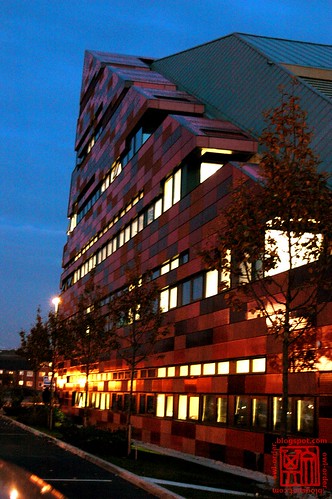
[HiRes] This is labelled "International Office", but I call this the Lego Building. There are two Lego Buildings actually.
Ultra round curves. Needle sharp points.
Reflective lights. Inclined surfaces. Spirals.
All these made the sights at the campus simply breathtaking at night.
The tallest structure in the Jubilee Campus is the Aspire.
The Aspire is a 60m free standing sculpture, situated in the middle of the Jubilee Campus. Its fame rivals that of the Trent Building clock tower, shown in the first picture of this post.
And what rivalry it is too. The old and the new. The traditional and the modern. The conservativeness and the open-mindedness. The comfort of familiar and the excitement of change.
The library is rather cool as well.
It has an inverted cone shape, with the tip facing down, as if it were plugged halfway into the lake.
At first sight, you may think that I didn't hold my camera perfectly horizontal when I shot the picture.
Look carefully, and you'll realise that you're wrong. Search for the horizon. Look at the ripples. And you'll soon see that it wasn't my camera.

Look at the ground and you'll realise the camera was held perfectly horizontally -- it was the Library that wasn't horizontal.
It was the building. The entire library goes up in a single spiral. So one can say it is a single-storey library, or a 3.5-storey one. And so yes, it's a cone-screw.
Cool right? Heck, even its full name is different. The Sir Harry and Lady Djanogly Learning Resource Centre.
And if you were to think there's nothing else to see here, you would be wrong -- I haven't covered day time yet.
Labels:
Owl's Eyes
Subscribe to:
Posts (Atom)









